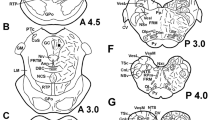Abstract
The undecapeptide substance P is a putative neurotransmitter in the mammalian central nervous system (CNS), and may be associated with pain fibres in the spinal cord1,2. Radiolabelled derivatives of other neuropeptides havd been used to demonstrate specific interactions with receptor sites on brain membranes3–6, and this approach has now been explored with substance P. We have now prepared [4-3H-Phe8]-substance P and we find that it binds reversibly to a saturable population of sites in rat brain particulate fractions. Scatchard analysis of concentration-dependent saturation of binding indicates a single population of non-interacting sites with a high affinity (Kd = 0.38 nM) and a low density (Bmax = 27.2 fmol per mg protein). Kinetic analyses indicate an apparent dissociation equilibrium constant of 0.46 nM. A variety of neurotransmitter amines and amino acids, and other peptides do not compete at the substance P sites, but structurally related peptides or shorter C-terininal fragments of substance P are active. The rank order of potency of these substance P-related peptides agrees with that reported for their effects in depolarizing spinal cord neurones7. The regional distribution of the specific binding sites for 3H-substance P parallels that of substance P immunoreactivity, being high in the hypothalamus and low in the cerebellum and cerebral cortex. The characteristics of the 3H-substance P binding sites are consistent with those expected for substance P receptors.
Similar content being viewed by others
References
Cuello, A. C. et al. in Centrally Acting Peptides (ed. Hughes, J.) 135–156 (Macmillan, London, 1978).
Piercey, M. F., Einspahr, F. J., Dobby, P. J. K., Schroeder, L. A. & Hollister, R. P. Brain Res. 186, 421–434 (1980).
Moody, T. W., Pert, C. B., Rivier, J. & Brown, M. R. Proc. natn. Acad. Sci. U.S.A. 75, 5372–5376 (1978).
Sirett, N. E., McLean, A. J., Bray, J. J. & Hubbard, J. I. Brain Res. 122, 299–312 (1977).
Taylor, D. P. & Pert, C. B. Proc. natn. Acad. Sci. U.S.A. 76, 660–664 (1979).
Kitabgi, P. et al. Proc. natn. Acad. Sci. U.S.A. 74, 1846–1850 (1977).
Otsuka, M. & Konishi, S. Cold Spring Harb. Symp. quant. Biol. 40, 135–143 (1976).
Brundish, D. E. & Wade, R. J. Chem. Soc. Perkin Trans. I, 2186–2189 (1973).
Lee, C. M., Emson, P.C. & Iversen, L. L. Life Sci. (in the press).
Floor, E. & Leeman, S. Analyt. Biochem. 101, 498–503 (1980).
Bertaccini, G. Pharmac. Rev. 28, 127–177 (1976).
Kanazawa, I. & Jessell, T. Brain Res. 117, 362–367 (1976).
Bury, R. W. & Mashford, M. L. Aust. J. exp. Biol. med. Sci. 55, 671–735 (1977).
Piercey, M. F. & Einspahr, F. J. Brain Res. 187, 481–486 (1980).
Erspamer, G. F., Erspamer, V. & Piccinelli, D. Naunyn-Schmiedebergs Archs Pharmak. 311, 61–65 (1980).
Couture, R., Fournier, A., Magnan, J., St. Pierre, S. & Regoli, D. Can. J. Physiol. Pharmac. 57, 1427–1436 (1979).
Nakata, Y., Kusaka, Y., Segawa, T., Yajima, H. & Kitagawa, K. Life Sci. 22, 259–268 (1978).
Mayer, N., Lembeck, F., Saria, A. & Gamse, R. Naunyn-Schmiedebergs Archs Pharmak. 306, 45–51 (1979).
Saria, A., Mayer, N., Lembeck, F. & Pabst, M. Naunyn-Schmiedebergs Archs Pharmak. 311, 151–157 (1980).
Putney, J., Van De Walle, C. & Wheeler, C. J. Physiol., Lond. 301, 205–212 (1980).
Jensen, R. T. & Gardner, J. D. Proc. natn. Acad. Sci. U.S.A. 76, 5679–5683 (1979).
Snyder, S. H. & Bennett, J. P. A. Rev. Physiol. 38, 153–175 (1976).
Author information
Authors and Affiliations
Rights and permissions
About this article
Cite this article
Hanley, M., Sandberg, B., Lee, C. et al. Specific binding of 3H-substance P to rat brain membranes. Nature 286, 810–812 (1980). https://doi.org/10.1038/286810a0
Received:
Accepted:
Published:
Issue Date:
DOI: https://doi.org/10.1038/286810a0
- Springer Nature Limited
This article is cited by
-
Interactions between tachykinins and diverse, human nicotinic acetylcholine receptor subtypes
Neurochemical Research (1996)
-
Autoradiographic distribution of substance P receptors in rat central nervous system
Nature (1983)





